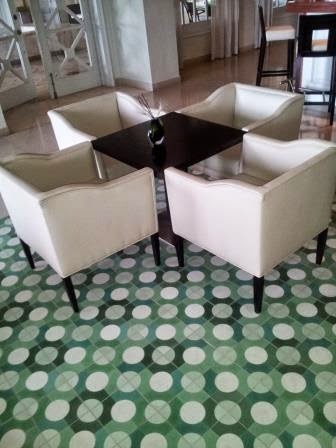Making Cement Tile: A Primer
Posted by William Buyok on
Creating the Guide to Buying Handmade Cement Tile was a labor of love. It seems appropriate because making cement tile is also a labor of love. The Guide helps you understand the nuances of cement tile, how it's made and and how it differs from ceramic or porcelain tile. Cement tile is one of the most beautiful types of tile available and capable of transforming a space into a personal expression of beauty. However, the handmade beauty, quality and durability of cement tile isn't always immediately obvious. For that reason, Avente Tile created the Cement Tile Buying Guide to help you make sense of the choices available and to help you decide if cement tile is right for you.
In my last post, I introduced Avente Tiles Guide to Buying Handmade Cement Tile. This 14-page downloadable Guide features information, examples of cement tile installations, FAQs, and more. To understand the nuances of cement tile, let's look at what cement tile is, and how it differs from ceramic or porcelain tile.
 |
| Handmade Alcala Cement Tile on a bathroom wall. |
What is Handmade Cement Tile?
Cement tile go by many names. They are made of concrete and called cement tiles to distinguish them from ceramic tiles. When making cement tile, a hydraulic press is used. Therefore, cement tiles are also commonly called hydraulic Tiles which describes the manufacturing process - each tile is hydraulically pressed under high-pressure. Cement tiles, also known as encaustic tiles, were first created in the mid-19th century in Europe. They were originally used only in prestigious buildings and high-end homes, but by the turn of the century, cement tiles could be found in homes all over the country.
 |
| Handmade cement tile in geometric shapes elegantly define a clubhouse restaurant's floor. |
Unfortunately, around the 1960s and 70s, cement tiles fell out of favor. Thankfully, the need for using green sustainable building products has created a renewed interest in cement tile. The wide array of available colors, custom patterns, and the matte finish of the tiles makes them a fresh, yet practical choice for those desiring something unique, sustainable and timeless.
Cement Tiles are:
- Durable
- Long-Lasting
- Sustainable
- Recyclable
- Handmade
- Extensive Color, Design Options
Making Cement Tile: The Manufacturing Process Explained
Cement tiles are handmade using a traditional, centuries-old, manufacturing process requiring several steps. Making cement tiles is a labor-intensive process and one of great pride for the tile maker and his helper. In fact, techniques are often passed down from one generation to the next. Cement tiles are much thicker than ceramic tiles and are not kiln-fired. You can see the extensive process of creating individual handmade cement tiles on the blog post, Aguayo Cement Tile Factory Tour.
 |
|
Color mixtures are hand-poured into molds or grids in which the designs of the cement tile are formed.
|
First, the color layer is prepared using a mixture of marble powder, white cement and pigmented minerals. The color mixture is hand-poured into molds which create the tile designs or patterns. The mold is extracted. Next, a layer of cement and sand is added, thus providing a bond between the color layer and the body of the tile. Finally, a layer of cement, sand and aggregate is added to complete the tile body. Each cement tile is then hydraulically pressed to remove water, increase density and provide strength. The tiles are racked and then cured underwater for a day. After about 28 days of being air-cured, the tile's concrete reaches about 98% of it's strength, after which it is now ready to be packed and shipped.
 |
| Handmade cement tiles are dried and set to age on racks, allowing them to harden prior to shipping. |
Because of the steps needed to create a high-quality cement tile, the cost per tile can range from $12 to $25 per square foot. It can take eight to 10 weeks for your tile to be made. If you choose a customized color or patterns that require a new mold, then the length of time for delivery, as well as cost, will increase.
Remember, making cement tiles is a slow, hand-made process. Each tile is produced one tile at a time, making each tile unique and different. You'll see the hand of the artisan tile-maker in each cement tile with slight variations in color, shade, and pattern.
Share this post
- Tags: Cement Tile Manufacturing Process, Custom Tile, Encaustic Tile, Handmade Tile, Making Cement Tile, Manufacturing Cement Tile
